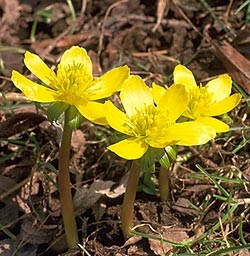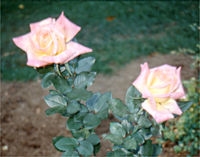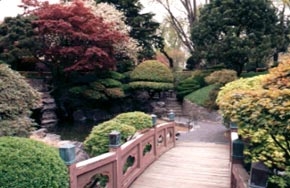 |
| Elizabeth Scholtz at Brooklyn Botanic Garden |
"My favorite month at the garden is April. It is absolutely the most beautiful. I love the early flowering trees, the magnolias, the cherry trees," says Dr. Elizabeth Scholtz, director emeritus of Brooklyn Botanic Garden, strolling among the plants she knows and loves so well.
Scholtz walks quickly, belying her 85 years. She graciously stops for any volunteer or staff member who asks her for information or calls out "Betty" when she passes.
"Betty is one of a kind. Her impact as an expert in public gardens is felt throughout the world," says Brooklyn Botanic Garden President Scot Medbury. "[She] is so smart, so gracious and has such aplomb. I am always impressed by how contemporary she is in her outlook."
A young child holds out a handful of pink flowers gathered from beneath one of the trees in the Conservatory's tropical garden. Scholtz speaks encouragingly to the toddler, which reassures the child's mother that it is quite all right to pick up the fallen blossoms.
 |
| Eranthis hyemalis (winter aconite) (http://www.bbg.org/gar2/topics/plants/images/ 2006sp_springpeepers2.jpg) |
"Look at that, look at that," Scholtz says excitedly, pointing to a cluster of small yellow flowers (winter aconite) decorating the winter-gray grass. "They always come out early; they are Eranthis hyemalis," she says, using botany's international language of Latin.
Like many in New York City, Scholtz moved here from someplace else. "I came to New York from South Africa 45 years ago. I had just broken off with my last boyfriend," she says — and something in that phrase causes her to chuckle — "when a letter came from George Avery, the [garden's] director, inviting me to come to work at the Brooklyn Botanic Garden.
"I thought they were out of their minds because I hadn't worked as a botanist for 20 years. But I decided that I should stop being a playgirl and become a serious professional."
 |
| "Elizabeth Scholtz" (Grandifloria) (http://www.bbg.org/exp/roses /images/elizabeth_scholtz.jpg) |
"Betty is an unsung hero," says Sharon Myrie, the garden's vice president of education. "She was the first woman to lead a botanical garden in the United States, and many women admire her for being the first in this field. She has a wealth of wisdom and knowledge, and provides answers to anyone to help them succeed."
Taking leadership wasn't easy. "I was given incredible challenges," Scholtz says. "There was vigor at the Botanic Garden. Thank goodness I was young enough, energetic enough to do everything that was asked of me."
The garden began in 1910 when a businessman, Alfred T. White, donated the land, which had been an ash dump. Today, Brooklyn Botanic Garden has 52 landscaped acres. "We will be celebrating our 100th anniversary in four years," Scholtz notes.
"The first director, [Charles] Stuart Gager, was very farsighted, and he decided that the garden should go into the direction of education for everybody. We have more than 175 courses and tours for adults, and thousands take classes every year."
"In 1913," Scholtz continues, "Dr. Gager persuaded a young woman to give up medical school and start first children's garden in a botanic garden anywhere in the world. Ninety-three years later and children are still coming to the garden."
At the children's garden, kids ages 3 to 13 learn how to grow vegetables, plant window boxes and care for trees. Sometimes, Scholtz says, the garden's staff learns from them.
"We once received this letter from a 7-year-old boy, saying, 'You have a poisonous tree in the garden and you identify it by saying: poison sumac. But a lot of the people who come to the garden can't read English. You should please have a skull and crossbones sign.'" Thanks to the boy's suggestion, a skull and crossbones now warns visitors of the toxic plant.
 |
| Map of Brookly Botanical Garden (http://www.bbg.org/exp/maps/images/bbg_map_1000.gif) |
Seventeen years ago, Scholtz retired from her job as director of the garden — but she couldn't stay away.
"They gave me a huge retirement party, just delightful," she says. "They named part of this building for me, and named a rose for me. Then they asked what I was going to do, and I said I'm coming back to work." She volunteers five days a week, from 9 to 5.
"As director emeritus, I am proudest that 14 years ago I decided we should be running horticultural tours around the world," Scholtz says. "This September, I will be leading the 96th tour. We have taken tours to 42 countries."
She returns fees from the tours and speaking engagements to the garden as a donation. The garden tours are her vacations. Scholtz cites her mother as her biggest influence. "My mother had grown up on a farm. She studied to be a nurse and married my father, who was a surgeon. They had a wonderful marriage, but then my father died suddenly.
"So here was a 35-year-old woman with three children, 11, 6 and 2, and she bought a tree farm. She always had gardens. When she bought the farm, the first thing she did was build a garden, then she built a house."
When she was 16, Scholtz told her mother she was thinking about botany as a career. Her mother encouraged her and said, "You can always work with plants."
"I have blessed her ever since," says Scholtz.
 |
| Japanese Garden (http://www.bbg.org/exp/ stroll/images/japanese1.jpg) |
The Brooklyn Botanic Garden has the largest bonsai tree collection outside of Japan — but the miniature trees didn't always get such a prominent place.
"Ever since 1925, there has been a bonsai collection here," Scholtz explains. "The first director looked at those contorted, miserable trees and thought nothing of them. The trees were shoved in a corner and many of them died."
That changed after World War II, she says. "Soldiers returned with bonsai in their backpacks. The soldiers made a beeline to the Brooklyn Botanic Garden to ask how to care for their miniature trees. As a result, this collection has grown to be many hundreds."
escorted a member of the Japanese royal family there and was told "the Princess Chichibu did not speak any English."
"I was talking to her through her secretary," Scholtz says. "We were in the Japanese garden near the waterfalls and pools, and I was rushing, and all of sudden I realized the Princess was not standing beside me. She was watching one of the pools.
" 'Look,' the Princess said, pointing, 'Ducklings.' And I discovered that she did speak English."
The walk comes to an end near the elaborate wrought-iron gates at the entrance. There is a sense of sadness when the time comes to leave the garden. Yet, it is impossible to feel down around a woman who is so in love with life and nature.
"When I think of my life," says Scholtz, "I see it as I come into the garden at all seasons; seeing the autumn leaves, the snow. The best part is seeing the garden come forth in the spring."
Page created on 5/23/2006 12:00:00 AM
Last edited 5/23/2006 12:00:00 AM
